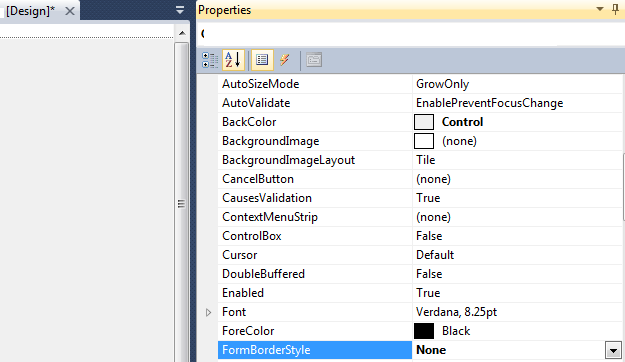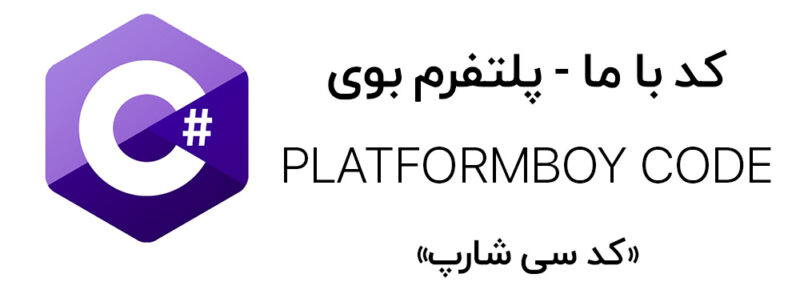سی شارپ
مخفی کردن نوار ویندوز در سی شارپ #C

روش اول مخفی کردن نوار ویندوز
می توانید برای مخفی کردن قسمت بالای نوار ویندوز یا به اصطلاح در برنامه Winform از دو قطعه کد قسمت فرم و دیزاینر زیر استفاده کنید . در صورت نیاز هر دو کد را کپی پیست نکنید . برای هر قسمت کدها را بررسی کرده و در برنامه خود جایگزین کنید .
قطعه کد form1 :
using System;
using System.Collections.Generic;
using System.ComponentModel;
using System.Data;
using System.Drawing;
using System.Linq;
using System.Text;
using System.Threading.Tasks;
using System.Windows.Forms;
namespace BorderExp
{
public partial class Form1 : Form
{
public Form1()
{
InitializeComponent();
}
private void Form1_Load(object sender, EventArgs e)
{
FormBorderStyle = System.Windows.Forms.FormBorderStyle.None;
}
private void ExitClick(object sender, EventArgs e)
{
Application.Exit();
}
private void MaxClick(object sender, EventArgs e)
{
if (WindowState ==FormWindowState.Normal)
{
this.WindowState = FormWindowState.Maximized;
}
else
{
this.WindowState = FormWindowState.Normal;
}
}
private void MinClick(object sender, EventArgs e)
{
this.WindowState = FormWindowState.Minimized;
}
}
}
قطعه کد دیزاینر فرم 1 :
namespace BorderExp
{
partial class Form1
{
/// <summary>
/// Required designer variable.
/// </summary>
private System.ComponentModel.IContainer components = null;
/// <summary>
/// Clean up any resources being used.
/// </summary>
/// <param name="disposing">true if managed resources should be disposed; otherwise, false.</param>
protected override void Dispose(bool disposing)
{
if (disposing && (components != null))
{
components.Dispose();
}
base.Dispose(disposing);
}
#region Windows Form Designer generated code
/// <summary>
/// Required method for Designer support - do not modify
/// the contents of this method with the code editor.
/// </summary>
private void InitializeComponent()
{
this.button1 = new System.Windows.Forms.Button();
this.button2 = new System.Windows.Forms.Button();
this.button3 = new System.Windows.Forms.Button();
this.SuspendLayout();
//
// button1
//
this.button1.Anchor = ((System.Windows.Forms.AnchorStyles)((System.Windows.Forms.AnchorStyles.Top | System.Windows.Forms.AnchorStyles.Right)));
this.button1.BackColor = System.Drawing.SystemColors.ButtonFace;
this.button1.BackgroundImage = global::BorderExp.Properties.Resources.blank_1_;
this.button1.FlatAppearance.BorderSize = 0;
this.button1.FlatAppearance.MouseOverBackColor = System.Drawing.Color.FromArgb(((int)(((byte)(224)))), ((int)(((byte)(224)))), ((int)(((byte)(224)))));
this.button1.FlatStyle = System.Windows.Forms.FlatStyle.Flat;
this.button1.Location = new System.Drawing.Point(376, 1);
this.button1.Name = "button1";
this.button1.Size = new System.Drawing.Size(27, 26);
this.button1.TabIndex = 0;
this.button1.Text = "X";
this.button1.UseVisualStyleBackColor = false;
this.button1.Click += new System.EventHandler(this.ExitClick);
//
// button2
//
this.button2.Anchor = ((System.Windows.Forms.AnchorStyles)((System.Windows.Forms.AnchorStyles.Top | System.Windows.Forms.AnchorStyles.Right)));
this.button2.BackColor = System.Drawing.SystemColors.ButtonFace;
this.button2.BackgroundImage = global::BorderExp.Properties.Resources.blank_1_;
this.button2.FlatAppearance.BorderSize = 0;
this.button2.FlatAppearance.MouseOverBackColor = System.Drawing.Color.FromArgb(((int)(((byte)(224)))), ((int)(((byte)(224)))), ((int)(((byte)(224)))));
this.button2.FlatStyle = System.Windows.Forms.FlatStyle.Flat;
this.button2.Location = new System.Drawing.Point(343, 1);
this.button2.Name = "button2";
this.button2.Size = new System.Drawing.Size(27, 26);
this.button2.TabIndex = 1;
this.button2.Text = "[]";
this.button2.UseVisualStyleBackColor = false;
this.button2.Click += new System.EventHandler(this.MaxClick);
//
// button3
//
this.button3.Anchor = ((System.Windows.Forms.AnchorStyles)((System.Windows.Forms.AnchorStyles.Top | System.Windows.Forms.AnchorStyles.Right)));
this.button3.BackColor = System.Drawing.SystemColors.ButtonFace;
this.button3.BackgroundImage = global::BorderExp.Properties.Resources.blank_1_;
this.button3.FlatAppearance.BorderSize = 0;
this.button3.FlatAppearance.MouseOverBackColor = System.Drawing.Color.FromArgb(((int)(((byte)(224)))), ((int)(((byte)(224)))), ((int)(((byte)(224)))));
this.button3.FlatStyle = System.Windows.Forms.FlatStyle.Flat;
this.button3.Location = new System.Drawing.Point(310, 1);
this.button3.Name = "button3";
this.button3.Size = new System.Drawing.Size(27, 26);
this.button3.TabIndex = 2;
this.button3.Text = "___";
this.button3.UseVisualStyleBackColor = false;
this.button3.Click += new System.EventHandler(this.MinClick);
//
// Form1
//
this.AutoScaleDimensions = new System.Drawing.SizeF(6F, 13F);
this.AutoScaleMode = System.Windows.Forms.AutoScaleMode.Font;
this.BackgroundImage = global::BorderExp.Properties.Resources.blank_1_;
this.ClientSize = new System.Drawing.Size(403, 320);
this.ControlBox = false;
this.Controls.Add(this.button3);
this.Controls.Add(this.button2);
this.Controls.Add(this.button1);
this.Name = "Form1";
this.StartPosition = System.Windows.Forms.FormStartPosition.CenterScreen;
this.Text = "Form1";
this.Load += new System.EventHandler(this.Form1_Load);
this.ResumeLayout(false);
}
#endregion
private System.Windows.Forms.Button button1;
private System.Windows.Forms.Button button2;
private System.Windows.Forms.Button button3;
}
}
روش دوم مخفی کردن نوار ویندوز
چنانچه فقط قصد دارید نوار دور کادر فرم باقی بماند از تک کد زیر در لود فرم خود استفاده کنید
![]() قطعه کدی که در زیر مشاهده می کنید توسط برنامه کامپایلر به جهت تست آزمایش شده و خروجی صحیح مدنظر را بدست آورد.
قطعه کدی که در زیر مشاهده می کنید توسط برنامه کامپایلر به جهت تست آزمایش شده و خروجی صحیح مدنظر را بدست آورد.
Me.FormBorderStyle = System.Windows.Forms.FormBorderStyle.None
روش سوم مخفی کردن نوار ویندوز
همچنین می توانید این قطعه کد را به فرم خود اضافه کنید تا به راحتی قابل کشیدن باشد.
درست قبل از سازنده آن را اضافه کنید (روشی که InitializeComponent را فراخوانی می کند )
private const int WM_NCHITTEST = 0x84;
private const int HTCLIENT = 0x1;
private const int HTCAPTION = 0x2;
///
/// Handling the window messages
///
protected override void WndProc(ref Message message)
{
base.WndProc(ref message);
if (message.Msg == WM_NCHITTEST && (int)message.Result == HTCLIENT)
message.Result = (IntPtr)HTCAPTION;
}
روش چهارم مخفی کردن نوار ویندوز
همانند تصویر زیر تنظیمات فرم را تغییر داده و قطعه کد نوشته شده را در فرم خود قرار دهید :

this.ControlBox = false; this.Text = String.Empty;


